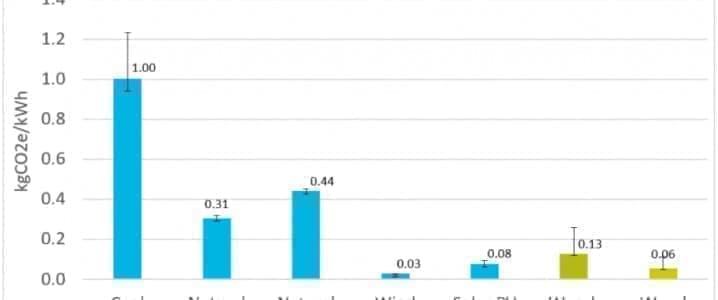One of the more controversial renewable energy resources is woody biomass, such as trees. It shouldn’t be, because biomass can be a highly sustainable resource if it is properly managed. I lived in Hawaii for five years, where I worked for a company that managed forests (among other things). I was sometimes asked to give talks at the local high school about energy and sustainability. During one talk, a student said “I heard you were going to cut down all the trees.”
At that moment, I realized that her view of forestry was much the same as my own view of forestry while growing up in Weyerhaeuser country in Oklahoma. Back then I viewed foresters as people who cut down trees, and I associated them with clearcutting.
Sustainable Biomass
My views have changed a lot since then, because I have a better understanding of what foresters do. Foresters manage forests. With a managed forest, sometimes that means you harvest the trees like you would harvest any other crop. But managing a forest also entails replacing what you cut down.
When considering biomass as a source of energy, there are many potential pitfalls. Some forms of biomass are heavy users of nutrients, and as such the fertilization requirements can be high. This can imply high fossil fuel inputs to produce the fertilizer and a higher risk of soil depletion. Also, some crops are heavy users of water.
Trees are different. During the first 10 years or so of their lives, they generate biomass at the rate of 7-10 bone-dry tons per acre per year. You may see some other biomass sources that claim yields that high, but those were almost certainly achieved with fertilizer and plenty of water.
But there is an even more compelling reason to utilize trees. Unlike most of the short-rotation crops that are sometimes discussed as feedstock for fuel production, trees can actually improve the quality and health of the soil.
What happens is that trees can bring up nutrients from the subsoil and concentrate them in the leaves and bark. This ends up falling back to the soil and adding to the organic material in the soil. Depending on the type of tree you use, managed forests can provide fuel while improving soil quality.
Recycling Carbon
Of course, a key question is the carbon footprint of using trees for fuel. Trees that are combusted for power release carbon dioxide recently sequestered by the tree.
During the cycle of growing and subsequently burning the tree, the net inventory of carbon dioxide in the atmosphere doesn’t change. This is different than burning coal, for example, which releases ancient carbon dioxide and increases the net inventory of carbon dioxide in the atmosphere.
In reality, there are additional factors that impact the carbon balance of wood-to-energy schemes. Tree roots, for example, sequester additional carbon below the soil. In some cases, those roots can last for decades, tying up carbon beyond what was in the usable part of the tree.
On the other side of the equation are any energy inputs it took to grow, transport, and convert the tree into a usable form, like pellets. However, a life cycle analysis (LCA) can sort out the various inputs and outputs and calculate a carbon footprint.
How Trees Stack Up
Fortunately, this has been done. Enviva Inc. is a publicly-traded Maryland-based company and the world’s largest producer of sustainable wood pellets. These pellets are primarily used to displace coal in European coal-fired power plants.
In 2019, one of Enviva’s largest shareholders asked independent research firm Boundless Impact Research and Analytics to review wood pellet energy's sustainability and carbon impact. Boundless used current peer-reviewed literature on the greenhouse gas (GHG) impacts of wood pellets to create an LCA of GHG emissions from the wood pellet supply chain. They compared the carbon footprint of wood pellets to other fuels like coal and natural gas.
Related: 2 ETFs To Bet On Amid Wild Uncertainty And Volatility
The report is available here, but there were a number of important findings. Notably, the report highlighted that wood-based bioenergy can complement intermittent resources like wind and solar power with firm energy. This is often done today with fast-cycling natural gas power plants, but wood pellets can achieve this at a fraction of the carbon footprint.

Source: Enviva Inc.
Coal has a greenhouse gas intensity of 1.00 kilograms of carbon dioxide equivalents per kilowatt-hour (kWH) of electricity produced. Combined-cycle (CC) natural gas was significantly better at 0.44 kgCO2e/kWh.
But electricity produced from sustainable wood pellets had a carbon intensity of only 0.13 kgCO2e/kWh – 87% lower than coal and 70% lower than natural gas for the full life cycle. When used in a combined heat and power (CHP) application, the carbon footprint for wood pellets dropped to 0.06 kgCO2e/kWh.
These factors were a major driver behind the European Commission’s 2020 climate and energy plan. Because it recognized that bioenergy could be sustainable and help Europe meet its carbon emissions targets, this plan helped create a booming wood pellet trade by companies like Enviva in Europe.
So, trees can be an ideal source of renewable energy if they are properly managed. Besides providing fuel and reducing carbon emissions, they can perform an important function of recycling nutrients from the subsoil to the topsoil. The trees that are cut down can be replanted. This is distinctly different from – and should not be confused with – using trees from rainforests or old-growth forests.
By Robert Rapier
More Top Reads From Oilprice.com:
- Oil Sands Financing From Canadian Banks Doubles
- India’s Russian Dealings Have Left Biden’s Geopolitical Oil Strategy In Tatters
- Tight Oil Markets Are Sending Fuel Margins Through The Roof


















